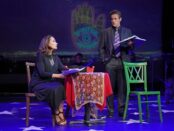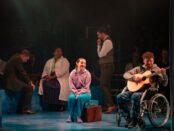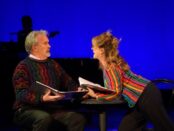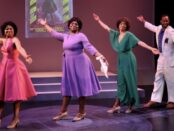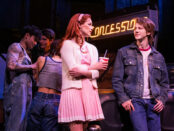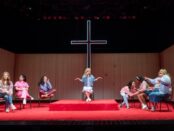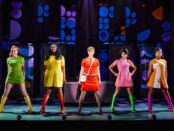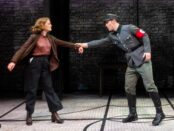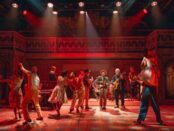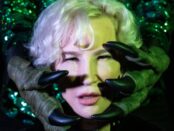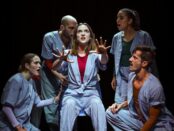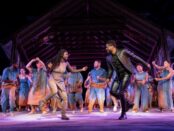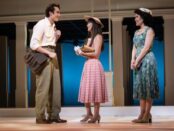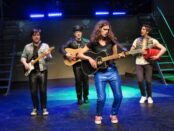Off-Broadway
This adaptation, directed by John Hickok, uses the Fitzgerald story as a counterpoint to a tale of a couple caught in the legal vagaries of the United States and Canadian immigration laws. The connection between their experiences at the border and the satirical nature of the Fitzgerald piece does not work even with the addition of musical numbers. It would be better to make a show of the original story without the contemporary border issues thrown into the mix. [more]
Twist of Fate
Levin’s lyrics have unusual and surprising rhyme patterns which add to their interest. The powerful score with music by Ron Abel (who also plays a mean piano with the orchestra of five which sounds much bigger than it actually is) is performed by big talent: Lianne Marie Dobbs’ Dominique, Ben Jones’ Michael Boardman, Maya Lagerstam’s Olivia and Allyson Kaye Daniel in a series of roles including that of the Evangelist impress with the size of their voices and their technique. The uncredited orchestrations include violin and bongo solos which add texture to the songs. [more]
Lifeline
However, instead of telling Fleming’s story in chronological order, it travels backwards and forwards in time beginning with Fleming’s Nobel Prize acceptance speech in Stockholm in 1945, then skipping to Athens, Greece, in 1952, then traveling back to New York and London’s St. Mary’s Hospital in 1946, then further back to St. Mary’s lab in 1940, and finally ending Act 1 with Fleming’s discovery of penicillin at St Mary’s in 1928. Not only does all this alternate with the Jess/Aaron story in Edinburgh in the present, it often divides the stage in two and tells both stories simultaneously. There seems to be no gain in telling Fleming’s story out of order, as it makes it confusing and hard to follow, while asking us to keep track of the contemporary story with its permutations and additional characters at the same time. [more]
Now Comes the Fun Part
The revue alternates between skits by James Hindman and Lynne Halliday and songs with music by Jeffrey Lodin (who is also the music director at the piano) and lyrics by Mark Waldrop, the intrepid director. While the material is diverting and entertaining, it feels derivative rather than original. There appears to have been an attempt to not offend anyone so that everything is rather low key and tame. Some of the tropes though pertinent have already been dramatized: “To You, My Friend,” sung by two women at a college reunion, resembles but feels like a pale imitation of Jerry Herman’s “Bosom Buddies” while “Gonna Get the Band Together” suggests the 2018 Broadway musical with a similar name. “Reunion” in which two old friends reminisce has too much the feel of a "Saturday Night Live" skit. [more]
Cats:”The Jellicle Ball”
The dynamic and exciting dances include the five elements of voguing: catwalk, duckwalk, hand performances, floor performances and spins and dips in various combinations. The competitions which include almost every song are taken from real ballroom events and the names are appear on the rear wall over the glitter curtain in Brittany Bland’s projection design. These include Virgin Vogue, Pretty Boy, Realness, Body, Bizarre, Opulence, New Way Vs. Old Way, Labels, Women’s, and All American. One razzle dazzle competition is the Tag Team Performance to the song “Mungojerrie & Rumpleteaser” which pitted “knockabout clowns” Jonathan Burke and Dava Havuesca in matching costumes with ballerina Baby as Victoria and gymnastic Bryce Farris subbing for Primo as Tumblebrutus. [more]
The Sabbath Girl: A New Musical
When was the last time you saw a new play in which you cared about the characters and wanted them to end up together? "The Sabbath Girl: A New Musical" is that kind of show. A delightful and charming rom-com adapted by Cary Gitter from his 2020 play of the same name, "The Sabbath Girl" brings together two unlikely people from very different worlds, both at crossroads in their lives. With sensitive performances by Marilyn Caserta and Max Wolkowitz, lovely music by Neil Berg, graceful and emotional lyrics by Berg and Gittter, and a poignant story, The Sabbath Girl is a must-see this summer. [more]
Empire
In "Empire," Caroline Sherman and Robert Hull attempt to tell a very big story but are unable to bring this unwieldy tale into suitable shape. The time traveling framework is both unnecessary and obtrusive. Both the historic characters and the fictional ones are underwritten and there are too many names to keep straight. While the music is catchy, the lyrics are often too unsophisticated and repetitious to make their mark. The cluttered setting and the busy staging don’t help to tell the story. "Empire" is an ambitious but unsuccessful musical which is defeated by its very form. [more]
Titanic
The tapestry Stone weaves with his multitude of characters—too many to mention here—is always fascinating in its subtle details. Each person stands on his or her own helped by superb performances by the entire cast under the skilled direction of Anne Kauffman ("Mary Jane" and "The Sign in Sidney Brustein’s Window"). Under her care they all sing magnificently helped by guest music director Rob Berman’s sensitive handling of the Yeston score, directing the large Encores! Orchestra to bring out all the facets of the almost operatic music. [more]
David, A New Musical
"David" now at the AMT Theater is an ambitious Off Broadway musical dramatizing the story of the youth of the hero David, later second king of Israel. It has a bouncy contemporary score by Albert Tapper and a large talented cast. Somewhat indebted to Andrew Lloyd Webber’s Biblical musicals, it is narrated by the older King David on his deathbed to the Prophet Nathan. Most of David’s adventurous exploits take place off stage, while the dramatized scenes are mainly political and dramatic. [more]
The World According to Micki Grant
Grant’s work is well-known to many, but this intimate, compact little revue featuring four actors, Matelyn Alicia, April Armstrong, Patrice Bell and Brian Davis, is an enjoyable, informative, and intimate love letter celebrating Grant anew. Although known for writing the 1959 single “Pink Shoe Laces” (sung by bobby sox darling Dodie Stevens), and the more visible musicals "Your Arms Too Short to Box with God" and "Cope," the evening’s offerings include many lesser-known works by Grant as well as unpublished songs, narratives, and poems, all demonstrating the broad, deep, and cutting edges of her humor, observation, and thought provocation in subjects running the gamut from love, war, rebellion, and justice. Days later, I’m still singing her two big songwriting numbers from the Stephen Schwartz musical "Working," “Cleanin’ Women” and “If I Could’ve Been” in my head. [more]
Three Houses
Someone once coined the adage, “Write what you know.” For the past few seasons, we have seen many writers have a lot to say about surviving the Covid lockdown, but none so eloquently as Dave Malloy in "Three Houses." Where there is often the sameness in the stories we’ve heard thus far, Malloy chooses to give us three not so disparate individuals each with a particular heartbreaking loneliness. All three tales are prefaced “so this is the story of how i went a little bit crazy living alone in the pandemic.” Where aloneness is ripe for scenes that are maudlin, Malloy setting these tales to music is rapture. [more]
Winesday: The Wine Tasting Musical
When it comes to coffee klatches, wine seems to be a good substitute, or at least that is the case with the women in "Winesday: The Wind Tasting Musical," with book and lyrics by Jenne Wason and music by Joseph Benoit. It is a show that could leave you tipsy at the end but generally satisfied with the experience. The songs are clever and well-sung by a solid group of five actors, and the book doesn't rely on a straightforward plot but provides a series of entertaining vignettes that help define the characters' lives with details about their ups and downs. Jamibeth Margolis's direction effectively guides the cast to deliver funny, well-integrated performances in a constrained setting. [more]
My True Love: A Perfect Musical Fairytale
'My True Love: A Perfect Musical Fairytale" is a musical fairy tale, written by Ben Boecker, about the choices made when the world is a place of dreams. Solid direction by Carolyn Popadin guides the diverse cast as it takes the audience on a romp through a magic land of self-discovery as a young witch explores the complex ideas surrounding consent, self-realization, and acceptance. Don’t let the heavy-sounding themes throw you off; the show is a frothy musical comedy with a good ensemble and a couple of outstanding individual performances. It intentionally comes close to a feeling of a student production, but that idea strongly supports the overall thrust of the show. [more]
David and Katie Get Re-Married
"David and Katie Get Re-Married" is the creation of David Carl and Katie Hartman. Using original songs, funny and timely commentary, and interesting props, they take a musical romp through the trials and tribulations of tying the knot again. Michole Biancosino provides outside-the-box direction for the humorously demented exploration of whether marriage is an institution or whether the people doing it should be institutionalized. In the end, it becomes clear that it is, maybe, both. It is a show to be savored in the afterglow of the experience. [more]
The Outsiders: A New Musical
The cast of "The Outsiders: A New Musica"l bring their own substantial charisma to the stage, but it's been dramaturgically constrained by Adam Rapp and Justin Levine's book, which sacrifices poetry for explanation. That unfortunate choice is abetted by a score from Levine, Jonathan Clay and Zach Chance (the latter two comprising the folk duo Jamestown Revival) that, influenced by "Oklahoma!" instead of pure sentiment, is far too Rodgers and Hammerstein, when it should have aimed for Rodgers and Hart. [more]
Teeth
Sarah Benson’s direction is spot-on, but we find ourselves wishing the closing scene was more than just a plethora of bloody penises. This is where the creatives needed to say, “Okay, this is probably not what we wanted to say”. Adam Rigg’s scenic design though spare, is perfect for a mid-America room that can pass as a small church, or AA meeting. The neon cross is a great touch and Jane Cox and Stacey Derosier’s changing colors do not go unnoticed…particularly when the cross is pink amidst a lavender wash when Ryan is in the scene. Enver Chakartash’s costume design is appropriate across the board, although the women’s outfits in the closing scene are a mélange of Tina Turner’s castoffs from "Mad Max Beyond the Thunderdome." Choreographer Raja Feather Kelly provides fine ensemble suites for the Promise Keeper Girls. [more]
A Sign of the Times
This York Theatre Company production at the New World Stages, following a presentation at Goodspeed Musicals in 2016, shoehorns these songs into a book by Lindsey Hope Pearlman from a story created by Richard J. Robin. It has an ambitious plot that glibly takes on a number of themes roiling through the turbulent Sixties: women’s lib, civil rights, the war in Vietnam, the sexual revolution, Andy Warhol, and even a premature touch of gay liberation. [more]
Jelly’s Last Jam (New York City Center Encores!)
Does the New York City Center Encores! new production of "Jelly’s Last Jam" hold up against the original Broadway production (1992-1993) which starred Gregory Hines (Tony Award), Savion Glover, Keith David and Tonya Pinkins (Tony Award)? Yes, it does and makes a good case for Jam’s enjoying a strong future. This production, directed with verve and precision by Robert O’Hara, is both a fine musical and a fine drama, a diamond in the crown that is the Encores! thirty-year history. [more]
Five, The Parody Musical
When she arrives dressed in a white pant suit, Labeija steals the stage with Hillary’s number “Miss Me Now” which trumps them all with a series of Broadway parodies paying tribute to Clinton’s love of the theater, with recognizable quotes from "The Sound of Music," "Company," "Gypsy," "Chicago," "Evita," "Thoroughly Modern Millie" and "Dreamgirls." However, while all of this is clever, at times the show becomes “can you identify this parody.” A “Six Mixalot” for the company takes the same place as “The Megasix” in "Six." Lena Gabrielle does fine work with the four-person all-female band but the sound design by Bailey Trierweiler, Kevin Heard and Uptown Works is often too loud for this small Off Broadway theater. [more]
The Boy Who Listened to Paintings
Alyson Reim Friedman, Thom Brown III, Niko Zylik as young Nicky, Donovan Counts, Alisa Ermolaev and [more]
White Rose: The Musical
While we are presented with characters who are doing a noble thing and can be touched by what they go through to accomplish their task, Brian Belding’s book and lyrics repeatedly take us out of 1942. In breaking up a fight between her brother and her old flame, Sophie blurts, “Are we seriously doing this?!”…Seriously? The tone is not “then” in 1942, it’s a university student of present day. When Willi walks in on the scene, he asks “What the f*@k is going on?!” We don’t doubt the impulse behind it, but was that really the vernacular in 1942? Natalie Brice’s score has its moments with some of the solos, but the full company songs sound like retreads of "Les Miserables" chorus numbers. “Munich” sounds like “Blind Eye” sounds like “Why Are You Here?” sounds like “The Mess They Made” sounds like “We Will Not Be Silent.” All are full throttle songs with the same sentiment, so why are there so many? [more]
Once Upon a Mattress (New York City Center Encores!)
Of course, in true American musical theater form the elegant Princess has been transformed into the bedraggled and uncouth Winnifred (Foster, in her best goofy guise, proving her talent knows no boundaries). Winnie answers the call to audition to be the bride of the equally goofy Prince Dauntless (Michael Urie, funny, but hampered by his material’s lack of sophistication while taking a busman’s holiday after recently departing from "Spamalot)". The marvelously imperious Harriet Harris plays Dauntless’ mother, Queen Aggravain married to the mute, but highly communicative King Sextimus the Silent (David Patrick Kelly, adorable). [more]
The Greatest Hits Down Route 66
The title of Michael Aguirre’s "The Greatest Hits Down Route 66," the story of the Franco family’s road trip during the summer of 1999, refers to Carl Sandburg’s 1927 "The American Songbag,' a best-selling collection of early folksongs. Aguirre tells us that “the goal is to use music as a memory, an imprint, incidental. It should carry emotional weight but don’t depend on it to move the plot forward.” And that is the problem with the show: the songs are extraneous to the plot and have little impact as most of the 13 songs sung are so familiar, in the musical arrangements of Grace Yukich and Jennifer C. Dauphinais. There are no surprises in the music played by a three piece band and a lead vocalist, Hannah-Kathryn “HK” Wall. Occasionally, the narrator played by Joél Acosta joins in or sings a song himself. [more]
Brighter than the Sun
Hendley is solid in his performance as the narrator of his and his grandmother’s story. His presentation commands attention without demand, smoothly and effortlessly focusing on the words being spoken. He has created a show with a strong storyline but needs a rework of the structure. Although his narrational guidance is well-written and beautifully presented, it adds too much exposition when perhaps the information could be dramatized. [more]
Becoming Chavela
Ranchera is a style of traditional Mexican folk music with origins in the ranchos of rural Mexico. The songs are about love, patriotism, or nature and are usually sung by men. The vocals have a rough, raw quality in contrast to the more refined vocalizations of the urban singers. In Mexico City, Chavela defied the norms and sang rancheras with her style and interpretations while staying true to the rawness of delivery and the ideas expressed by the lyrics. Trudeau transforms herself into Chavela with an on-stage costume change and then provides solid interpretations of some of Vargas’ classic rancheras as she takes the audience on an exploration of Vargas' life in Mexico City, a brief time in Cuba and to the mid-1970’s when she stopped performing as a result of all the tequila she had consumed over the years. Although Trudeau's voice is more refined, she still delivers the songs with all the passion and fire needed in some and the introspection and sadness in others. Her embodiment of Vargas is complete. [more]
Buena Vista Social Club
While the exciting new stage musical Buena Vista Social Club shares the same name with the acclaimed 1999 documentary by Wim Wenders, playwright Marco Ramirez’s book for the new show takes a different approach to the true story now under the direction and development of go-to director Saheem Ali (Fat Ham) for new work by people of color. While the film took us to the recording studio and then interviewed or followed the daily lives of the major singers and musicians involved ultimately taking us to their July 1, 1998 Carnegie Hall concert, the stage show instead tells the 1956 backstory of several of the main characters after we meet them at the 1996 recording session. Although the film made the male singers Ibrahim Ferrer and Compay Segundo the main characters, the musical puts the focus on recording star Omara Portuondo. Both approaches contain the original songs sung by the Cuban music group of old timers that came together in 1996 to record an album of almost forgotten Cuban songs making both versions documents of the highest authenticity. [more]
An Axemas Story
Despite its fairy-tale plot, Axemas isn’t really suitable for children because of language and sexual situations, but everyone else will find something amusing in this rag-taggle production. An Axemas Story could use some tightening and more professional looking scenery, but it’s tongue-in-cheek fun, nevertheless. The score is beautifully played under the musical direction of Sara Linger and the keyboard expertise of Buck McDaniel. [more]
Killin’ Republicans
"Killin’ Republicans," concept and libretto by Dick D. Zigun and music by Arturo Rodriquez, directed by vagabond, is billed as a rock opera about violence towards certain Republican Party leaders since the mid-nineteenth century. It deals with a series of assassinations and attempted assassinations of Republican leaders from the 1850s to President Reagan in 1981. It is supposed to be a discussion about the reasons for the attacks and not a call for violence against Republicans. The entire show is sung or performed in spoken form in various styles as more of a concept concert than an opera. The libretto covers a wide range of events attempting to give context to the multiple incidents but fails to clarify the point of the show. It is a mistake in its present form. [more]
The Jerusalem Syndrome: A Musical Comedy of Biblical Proportions
"The Jerusalem Syndrome" is a pleasant new musical comedy with some fine clever songs and good comic moments. However, Don Stephenson’s production does not take the farcical elements far enough nor does he allow the cast to really have fun with their wacky roles. Playing this material mainly straight undercuts the inherent fun in the premise and plot as the Jerusalem syndrome is ripe for satire. [more]
The Gardens of Anuncia
Michael John LaChiusa’s "The Gardens of Anuncia" is an interesting attempt to tell choreographer Graciela Daniele’s adolescent story. Unfortunately, as of now the show does not make the case that her coming of age was that eventful or compelling. What we might like to know is about her famed career, but that sort of presentation has been done in "Fosse," "Jerome Robbins’ Broadway," and "Prince of Broadway," the Harold Prince story. "The Gardens of Anuncia" is pleasant enough but leaves one hungry for more. The magical realism elements might be more fleshed out and some of the unanswered questions that are coyly handled might be revealed. [more]
Hell’s Kitchen
"Hell’s Kitchen" is both ambitious and noble in its intentions. However, as of now the show on the stage of The Newman at The Public Theater is not there yet. With very few characters developed and too many unanswered questions, the show’s book needs a simple rewrite. The Alicia Keys' score which too often sounds the same could use a reshaping to find some climactic moments other than the drama in the story. The plot lines need to come together more, rather than as disparate elements that take us in new directions all the time. Ultimately, Hell’s Kitchen has great potential when these problems are addressed. [more]
Amid Falling Walls (Tsvishn Falndike Vent)
Director Matthew “Motl” Didner manages to make what might have been just a well-staged concert of moving songs into a dramatic whole with a deep feeling for the ebb and flow of emotions from happiness to hopelessness. "Amid Falling Walls"—an apt title, unfortunately, still consequential in 2023—does come during a spike in anti-Semitism. Though an entertainment, the show provides ample historical evidence of blind prejudice. If only the message could register. [more]
School Pictures
Milo Cramer’s delightful solo musical "School Pictures," part of a festival of new one person shows running in repertory at Playwrights Horizons, is wildly inventive, hilarious funny, and extremely insightful about adolescence, class, over-privilege and the New York education system. Almost entirely sung throughout, School Pictures tells us in a series of 11 songs about Cramer’s experiences working as a private tutor in NYC after school with mostly rich, brilliant students who are damaged by their parents – and their own – expectations. All of them hope to get into one of the eight elite specialized high schools for which they will need the SHSAT (Specialized High School Admissions Test) or top colleges and the competition as both the parents and students know is fierce. [more]
Emergence: Things Are Not As They Seem
Olson might very well be the three-way love child of Thomas Dolby, Bill Irwin, and Max Headroom. He carries the show with an unbridled, infectious, childlike enthusiasm, sharing what he knows and loves--science and music--using songs he wrote in his car and lyrics that support his storytelling. He puts on this show like a life-long project that he couldn’t wait to find the barn for. Olson reels us all in as he fills our minds with profundities in the same ease and flair he might have if he were telling us an evening of dad jokes. He shares postulates about time, space, color, light, thought, consciousness, love, and existence, in easy-to-grasp terms using purposeful words and with exquisite imagery. [more]
(pray)
nicHi douglas’ vision is one of evocative beauty, one that gives us stage pictures to treasure for some time. The seated women fanning themselves with beautiful white fans as they watch one of their own reading a passage or singing is a natural touch. Even the graphic for the show gives us pause – the word “pray” surrounded by two hands creating the parentheses denotes how personal the power of an individual’s prayer is. douglas’ church is almost utopian in its design in that it welcomes all with no judgment…even the “mixed company” of whites present at the service who might be startled by how genuinely euphoric the service is. Her choreography, like her direction, is empowered by a true spirit of celebration, reminiscent of the great Alvin Ailey masterwork, "Revelations." [more]
The Picher Project
"The Picher Project" is a bluegrass and folk-infused musical conceived and directed by Quentin Madia, with music, book, and lyrics by Madia and Lauren Pelaia. This show is based on real-life events that are not only a part of Oklahoma's history but also of the social and industrial history of the United States. Through words and songs, the story is told of how this gentle, quiet, rural area became the center of lead and zinc mining in North America, only to end up dead as the number one most polluted place in the United States. [more]
Saw The Musical: The Unauthorized Parody of Saw
"Saw The Musical: The Unauthorized Parody of Saw" begins with a picture perfect recreation of the disgusting bathroom from the first movie in the iconic horror franchise. Then the puppet (Billy) shows up, wishing us a hearty "Wilkommen, bienvenue, welcome." (Note: this review has spoilers for "Saw" the movie as well as "Saw The Musical.") The show is impressively done with a cast of three (with the exception of Detective Tapp, played via voiceover by Donnel Johnson). Danny Durr plays Gordon and Zepp, Adam Parbhoo plays Adam and Gordon's daughter Diana, and on opening night Gabrielle Goodman played Amanda, Ali and Jigsaw. Goodman in particular stands out with a lovely voice and excellent dance skills, but all three turn in solid performances. (Durr's wig is so good it deserves its own program credit.) [more]
Twisted
It takes considerable skill for competent actors to play at being bad actors, and many of the cast members succeed. It is not a bad play, but the overarching problem with the show is that it is playing to a niche audience. If you do not know anything about the B-movies of the 50’s and 60’s, you will react as I did in thinking it is a terrible play. If you are familiar with the work of Roger Corman, William Castle, or any other B-film directors, or any of the films, such as "Galaxy of Terror," "The Little Shop of Horrors," "The Tingler," "The Curse of the Werewolf," or any of the dozen movies of that period, you may enjoy this production [more]
Golden Rainbow
The 1968 musical 'Golden Rainbow" (the show that gave us the song sensation “I’ve Gotta Be Me”) was so identified with its stars Steve Lawrence and Edie Gormé that it has not been seen in 55 years. When it was suggested to composer Walter Marks that he revisit the show, he found it had so much material created specifically for the Lawrences that it was no longer revivable. Instead he has written a new version of the original book by the late Ernest Kinoy (his collaborator on the Broadway musical "Bajour") as well as five new songs. The results are a small but appealing musical comedy with a terrific jazzy score as directed and choreographed by Stuart Ross. [more]
Doris Day: My Secret Love
Borelli as Doris Day is charming and appealing; her voice is not quite as strong as Day’s, but it is pretty and expressive, especially in quieter, more intimate moments. At the peak of some songs, where she’s expected to sing out fully and with passion, her voice doesn’t quite have the strength. [more]
Relapse: A New Musical
In "Relapse" ’s most original conceit, a quartet called The Intrusive (Vinny Celerio, Audree Hedequist, Nicole Lamb and Zummy Mohammed) becomes a Greek Chorus, insinuating themselves into the minds of the four unhappy patients while commenting on the inner workings of their care. The four are nimble, vivid and sing well, choreographed by Freyani Patrice whose movements ooze, flit and crawl about the stage as these four surround each character. [more]
The Tempest (Public Works)
Visually, the show is not as effective as it might have been considering the play usually includes a great deal of magic. Here there is very little in the way of scenic illusions or legerdemain. Alexis Distler’s setting which makes use of some elements of the design for Hamlet, the previous staging on the Delacorte stage, a falling down mansion seemingly off its foundation, adds little to the production’s visuals. Except for the stunning harpy costume for Ariel by Wilberth Gonzalez, the rest of the designs are more than bland. The all-black leather creations for the Europeans give the production a contemporary look that feels out of place. The dozens of community partners dressed in matching blue and yellow outfits have been given little to do besides stand around as witnesses or hum to the large-scale musical numbers. [more]
How to Steal an Election: A Dirty Politics Musical
While the misnamed "How to Steal an Election: A Dirty Politics Musical" is no lost masterpiece and at times seems long, it is a diverting political revue which offers an interesting take on the politics of the last 180 years. With the charming Jason Graae at the helm, the rest of the talented cast keeps the show rolling merrily along. New faces Emma Degerstedt, Alex Joseph Grayson, Courtney Arango, Kelly Berman and Drew Tanabe demonstrate that they should have very successful and acclaimed careers before them from their work here. [more]
Cat Kid Comic Club
The family-oriented TheaterWorksUSA’s latest musical adaptation of the best-selling children’s novels of Dev Pilkey is "Cat Kid Comic Club: The Musical," an exuberant colorful one hour irreverent entertainment for children of all ages. Written by Kevin Del Aguila (book and lyrics) and Brad Alexander (music) who previously wrote the highly successful "Dog Man: The Musical" from the earlier Pilkey series, "Cat Kid Comic Club" is surprisingly faithful to the book of the same name and will not disappoint its many fans. With clever and imaginative direction by Marlo Hunter and her design team which uses puppets as well as live actors, the hard-working cast of six (almost all of whom appeared in TheaterWorks’ "Dog Man" musical) play multiple roles to tell this hilarious and surprising story. [more]
Chanteuse
The Nazis persecuted not only Jews, political opponents and its own, but also homosexuals. Jews were forced to wear the infamous yellow stars; gays, the pink triangle. Alan Palmer, in his one-man show "Chanteuse" at HERE Arts Center, gives an intimate, heartbreaking look at one victim—fictional or not—that turns impersonal facts into passionate theater. [more]
Good Vibrations: A Punk Rock Musical
Terri Hooley (a game, genial Glen Wallace) is both the main character and the narrator of "Good Vibrations: A Punk Rock Musical" at the sparkling Irish Arts Center. How he morphed from Terry to Terri is a bloody tale that opens the show, albeit with a bit of winking Irish humor. Written by Colin Carberry and Glenn Patterson, "Good Vibrations" takes place in the 1970’s in a Belfast rife with violence, at the height of the inter-religious disturbances in Northern Ireland called The Troubles and is based on the 2012 film of the same name (which they also wrote). Terri Hooley is a real person and Good Vibrations paints a mostly complimentary portrait of this man who was so important to the music scene in Belfast. [more]
In Corpo
Press materials promise a work that is inspired by Kafka's "The Castle" and Melville's "Bartleby, the Scrivener." Both are name checked – the lead character is called K, played by a clear-voiced Zoe Siegel, and there is even a Bartleby (Austin Owens Kelly, doing triple duty on synthesizer and later acoustic guitar) who says "I prefer not to" very often – but "In Corpo" also owes something to Vaclav Havel's "The Memorandum" with its depiction of bureaucracy gone mad. Of course, not even Havel could have envisioned the tyranny of the complex password, something "In Corpo" uses to excellent comic effect. The show is at its best when it satirizes things that everyone has to deal with, such as passwords and inane tasks. [more]
Rock & Roll Man
"Rock & Roll Man," the new jukebox/biographical musical at the New World Stages has a great deal going for it. The story of legendary Rock & Roll impresario Alan Freed is told in a series of delicious period songs with a few original works (by Gary Kupper who also cowrote the libretto with Larry Marshak and Rose Caiola) thrown in. The show is basically factual, although a tad exaggerated, and doesn’t shy away from Freed’s well-known issues such as his alcoholism and taking payola. Best of all, the cast is led by Constantine Maroulis in a complicated, fine-tuned and, for him, subdued performance. [more]
The Gospel According to Heather
"The Gospel According to Heather," with book, music, and lyrics by Paul Gordon, is a story about a teenager's struggles with fitting in with her contemporaries, finding a boyfriend, and dealing with the supernatural powers which she seems to have acquired after finding a Roman coin in a fish. On the surface, this show appears to be a coming-of-age tale with music, but it is much more: it is a cleverly done and, at times, pointed commentary on the socio-political nature of contemporary America, and of religion. [more]
The Light in the Piazza
New York City Center Encores!’s new production of the musical, directed by Chay Yew, stars another Tony Award winner, the sensational Ruthie Ann Miles, as the determined Margaret Johnson with beautiful-voiced Anna Zavelson as a believably three-dimensional Clara. The Encores! production is more down-to-earth than either the film or the original Lincoln Center production and more satisfying as a human drama. There’s no stinting on humor, but the characters’ formerly trivial problems now seem more worthy of our attention. [more]
The Trouble with Dead Boyfriends
The show is a deft combination of action and humor with elements of horror. One of the production numbers, "Dissection Dance," is an homage to the "Time Warp" choreography of "The Rocky Horror Picture Show." The name of the high school, George R. Romero High School, invokes the zombie horror films he created. And with the ensemble's comedic timing, the show delivers an entertaining romp, with a feminist twist, through the psyche of three adolescent girls: Madison, Stella, and Grace. It needs a bigger stage and more actors but it is still an entertaining theatrical experience. [more]
Lizard Boy
Scheduled to run only until July 1, "Lizard Boy" deserves a longer life as one of the most satisfying musical theater offerings to be seen currently in New York. While the message of tolerance and diversity is not heavy, the theme is dramatized so that no one can mistake its intent. The three-person cast is superb in the acting, singing and musical departments. Brandon Ivie’s staging is clever and imaginative, while the book, music and lyrics by Justin Huertas make audience goers look forward to his next project with eager anticipation. [more]
Singfeld! A Musical Parody About Nothing!
Picking the easiest possible creative path, a decision the effort-averse George would no doubt admire, the McSmiths forgo imaginative risk-taking in favor of simply copying their source material, shaping "Singfeld!" as a parody musical about writing a parody musical. In other words, "Singfeld!" is also about nothing, which makes the entire endeavor feel, at times, akin to a Sartrean spiral or, as Jerry's archnemesis Newman (Jacob Millman) more bluntly puts it, "hackey." That's not to say there aren't some funny moments during "Singfeld!," but when humor is largely based on "remember when?," the comedic ceiling is right above your head. [more]
Days of Wine and Roses
Lucas’ script remains faithful to Miller’s teleplay (with the excision of Joe’s delirium tremens in the psycho ward or his second hospitalization) and much of the dialogue is actually Miller’s. However, the problem is the score. Guettel’s 18 songs (including four reprises) are often atonal, unmelodic, unrhymed and don’t scan. While this is true of the Tony Award-winning "The Light in the Piazza" that score had such a lush sound that it was automatically romantic and appropriate for its story. Here it is almost as though Guettel is striving for opera but without the orchestral underpinnings to make it so. The lyrics are mostly recitative, abstract and metaphorical. Aside from three songs in which Joe or Kirsten are joined by their seven-year-old daughter Lila (played by Ella Dane Morgan), only the couple sing, with O’Hara given seven solos. The real problem is as Stephen Sondheim said about his musical Do I Hear a Waltz?: these are characters that wouldn’t sing so the only way to solve this is to have made "Days of Wine and Roses" an opera with a great deal of orchestral music. Here the songs do not add anything to the story. Like Marvin Hamlisch’s score for the stage version of "Sweet Smell of Success," Guettel’s music is devoid of atmosphere, period or otherwise, unless this is the fault of the orchestrations by Guettel with additional orchestrations by Jamie Lawrence. [more]
Khan!!!The Musical, A Parody Trek-tacular
The music is well-done, with the songs fully integrated into the storyline and lyrics that help define essential elements of the character's nature and are filled with inside Star Trek references and jokes. For example, when Theerakulstit skillfully sings "Young," entirely in character as Kirk, we hear Kirk as an older man regretting getting old and no longer able to be the arrogant swashbuckling starship captain of his youth. When we meet Khan for the first time, Kropp sings “My Wrath,” which gives a history of how he came to be in this place and the reason for his extreme anger at Kirk. Although many of the references will be missed by a non-Star Trek audience, the songs are well-constructed, and more importantly, they are sung by a cast that knows how to sing on key and on pitch. While you may not leave the show humming a tune, they are the types of songs that one will return to without getting bored. [more]
Bliss Street
The main issue with this show is the lack of clarity in the book. Who is the play about, the father or the son? Act I is primarily a story about Paul Sub and his business ventures leading up to the creation of The Coventry. Act II is more about Charlie Sub and how his father's business decisions impacted Charlie's life. In both cases, the story's elements need to be restructured to make it more compelling. Does it matter what type of romantic relationship Charlie develops in LA? Did Paul's liquor store fail after the robbery? The book needs to be edited to define clearly which story is being told and to eliminate the scenes that do not advance the story. [more]
New York City Center Encores!: Oliver!
When Mary-Mitchell Campbell’s baton brought out the first notes of the "Oliver!" overture from the Encores! Orchestra, the memorable tunes just flowed and didn’t stop until more than two hours later at the standing ovation and exit music. Lionel Bart’s score is rich in melody, the lyrics and the libretto evoking Dickens while still being theatrical. (The late William David Brohn did the lavish orchestral arrangements.) Lear deBessonet, the show’s director (and the Encores!’ artistic director) has fashioned a fast-moving evening filled with great performances starting with the sweet, fresh-faced Oliver of Benjamin Pajak and the incredibly talented ensemble of kids who gambol about with abandon. [more]
On the Right Track
The latest collaboration by composer lyricist Albert M. Tapper and bookwriter Tony Sportiello, "On the Right Track," proves to be a charming chamber musical for three performers playing seven roles. The show combines realism with magic and the supernatural as it tells three stories which take place on a New Jersey Transit train. The Conductor, the narrator, also is a mystical figure who is able to give the characters second chances in life and lea them to a better place than when they came on board. Owing some inspiration to such classics as Sir James M. Barrie’s "Dear Brutus", Sutton Vane’s "Outward Bound" and Frank Capra’s "It’s a Wonderful Life," "On the Right Track" avoids being preachy at the same time that it offers suggestions about how to live one’s life. [more]
Vanities – The Musical
Although the women grow up and change over the 26 years we see them, Heifner’s book tends to stay away from politics and the women’s movement other than mentioning markers like Kennedy, Nixon and Bob Dylan. However, the dialogue is bright and lively. The show is definitely a period piece ending as it does in 1990 but there are probably women who still live these lives. While in no way taking a feminist point of view, the characters do evolve and change over the years. [more]
The Harder They Come
Celebrating the 50th anniversary of its original film release, Pulitzer Prize-winning playwright Suzan-Lori Parks has turned "The Harder They Come," the cult Jamaican film that starred later reggae legend Jimmy Cliff, into an exuberant stage musical now at The Public Theater. Led by British stage star Natey Jones and American Caribbean actress Meecah, the large cast does full justice to the new score which includes the ten songs used in the movie plus 26 other Jamaican and traditional songs, additionally interpolated ones by Cliff and others, and some with additional lyrics by Parks. There are also three original songs by Parks herself who when she is not involved with one of her plays fronts her own rock band. [more]


